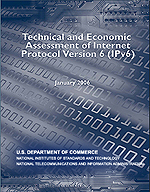
 |
Technical
and Economic Assessment of
Internet Protocol,
Version 6 (IPv6)
IPV6 TASK FORCE
U.S. DEPARTMENT OF COMMERCE
National Telecommunications and Information
Administration
National Institute of Standards and Technology
|
Commerce IPv6 Task Force
| Co-Chair
National Telecommunications and
Information Administration
Michael D. Gallagher, Assistant
Secretary for Communications and Information |
|
Co-Chair
National Institute of Standards
and Technology
Dr. William
A. Jeffrey, Director |
Task Force Team
| NTIA
Alfred Lee, OPAD Senior Advisor
and Team Co-Leader
Tim Sloan, Telecommunications
Policy Analyst |
|
NIST
Gregory Tassey, Senior Economist
and Team Co-Leader
Doug Montgomery, Manager, Internetworking,
Technologies Group |
Acknowledgments
NTIA and NIST would like to thank the
U.S. Department of Homeland Security; John M.R. Kneuer,
Kathy Smith, Stacy Cheney, Maureen Lewis, Sandra Ryan,
Randall Bloomfield, and the Office of International Affairs
of NTIA; Tim Grance and Sheila Frankel of NIST; and RTI
International for their contributions to this report.
We would like to give special thanks
to Dan Davis, B.K. Fulton, and Joseph Watson, Jr., for
their contributions while members of the Task Force
team.
TABLE OF CONTENTS
EXECUTIVE
SUMMARY
1
INTRODUCTION
1.1 The Internet Protocol and
IPv6
1.2 Current Market Activities
1.3 Department of Commerce IPv6 Task Force
2
BENEFITS AND COSTS OF ADOPTING IPV6
2.1 Relative Benefits of IPv6 vs. IPv4
2.2 Stakeholder Costs of Adopting IPv6
2.3 International Competitiveness
3
SECURITY IMPLICATIONS OF IPV6
3.1 Comparing IPv6 and IPv4
3.2 Reevaluating Existing Security Models
3.3 Security in Transition
4
INTEROPERABILITY
4.1 Interoperability Between
IPv6 Hardware and Software Applications
4.2 Interoperability Between IPv4 and IPv6 Hardware
and Software Applications
4.3 International Interoperability
5
GOVERNMENT’S ROLE IN THE EVOLUTION OF IPV6
5.1 Potential Market Failures and Underinvestment
in IPv6
5.2 Potential Roles for Government Involvement
in IPv6
6
FINDINGS
APPENDICES
Appendix A. Hypothetical Case
Study
Appendix B. RFC Commenters, Public Meeting
Panelists, Additional Participants
LIST OF FIGURES AND TABLES
FIGURES
Figure 2-1 NAT Operating between a Private
Network and the Internet 14
TABLES
Table 2-1 Overview of IPv6 Benefits
Table 2-2 Overview of Relative IPv6 Costs
Table 2-3 Relative Costs of IPv6 Deployment
by Stakeholder Group
Table A-1 Existing Infrastructure Components
and Annual Labor Expenses for Hypothetical Company A
Table A-2 Transition Phases and Associated
Costs
|